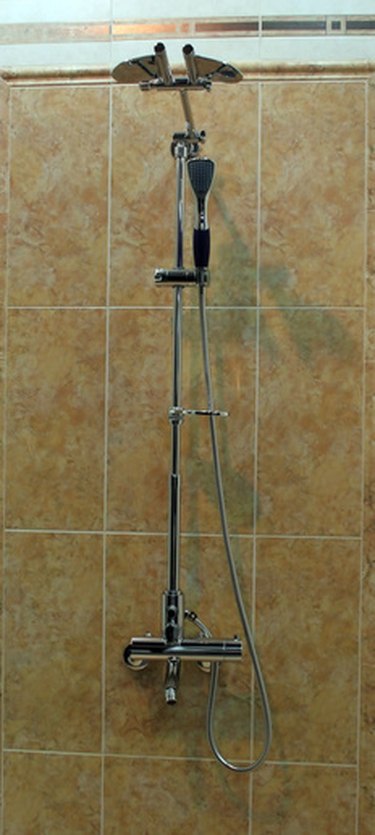Things You'll Need
Caulk removal tool
Razor blade
Rag (optional)
Bleach (optional)
Caulking gun
Caulk
Putty knife
Grout saw
Hammer
Cold chisel
Hair dryer
Tiling trowel
Tile adhesive
Replacement tile
Grout mix
Float
White vinegar or lemon juice
Silicon-based grout sealant
Applicator bottle or small paint brush

The bathroom is where much of the water in your house is used, making a leak in the bathroom tile a very urgent matter. If your tile shower is leaking, the cause of the leak must be found and addressed as soon as possible, and definitely before you take a shower again. Failure to do so puts more moisture behind the wall or under the floor, which can cause mold, rot in the wood structure or crumbling drywall.
Caulking
Step 1
Inspect the caulking that joins the tile wall to the shower pan or bathtub for mold, cracking or peeling.
Video of the Day
Step 2
Cut and peel out damaged caulk with a caulking removal tool. Continue removing caulk up to at least 2 inches past the damaged area. If you leave any of the old caulking behind, you do not want it also turning bad just a few months later.
Step 3
Scrape out sticky bits of caulk that were left behind from Step 2 with a razor blade. Clean the empty joint with an old rag and bleach if the caulk was moldy. Allow the empty joint to dry.
Step 4
Apply a bead of fresh caulk into the joint with a caulking gun, using steady, even pressure on the trigger.
Step 5
Shape the caulk to match the existing old caulk, if any, or however else you desire with a caulk-shaping tool or your finger. Remove excess caulk with a putty knife. Allow the caulk to set overnight before using the shower again.
Tile Repair
Step 1
Scrape out all the grout surrounding the damaged tile with a grout saw.
Step 2
Shatter the damaged tile with a hammer and chisel.
Step 3
Pry out any bits of tile still stuck to the wall by placing the edge of the chisel under the edge of the tile and striking it with the hammer.
Step 4
Remove the stuck bits of tile adhesive from the wall by heating them into a soft consistency with a hair dryer and then scraping them off with a putty knife.
Step 5
Coat the empty space in the wall with tile adhesive using a tiling trowel. After an even coat is on the wall, give it a ridged surface by drawing the notched side of the tiling trowel across it.
Step 6
Set the replacement tile onto the wall by pressing it into the adhesive and giving it a slight turn. That ensures a good grip on the adhesive. Then return it to a position where it is straight and aligned with the surrounding tiles.
Step 7
Wait at least 30 minutes and then mix some grout following the manufacturer's instructions. Push the grout into the channels around the replacement tile with your float. Allow the grout and adhesive to harden overnight.
Step 8
Clean up the tile. Scrape away any excess grout with the putty knife and wipe grout residue away with a sponge and either white vinegar or lemon juice.
Step 9
Wait at least 48 hours and seal the grout. Apply silicon-based grout sealant to the grout with a sealant applicator, which looks like a bottle with a roller on the nozzle. If you do not have such an applicator, a small paint brush will do the job as well.
Tip
Do not use your shower for two to three days after grouting the tile, to allow the grout and adhesive to fully harden.
Video of the Day